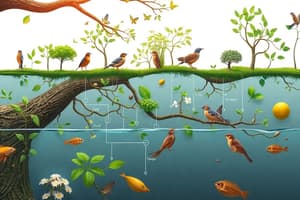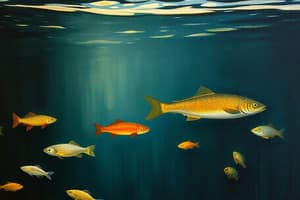Podcast
Questions and Answers
What is the primary source of energy for all trophic levels in a food chain?
What is the primary source of energy for all trophic levels in a food chain?
- The energy stored in the bonds of organic molecules.
- The consumption of other organisms by predators.
- The decomposition of dead organisms.
- The energy captured from sunlight by autotrophs. (correct)
A food chain can be described as a linear sequence of organisms that:
A food chain can be described as a linear sequence of organisms that:
- Depend on each other for survival and energy flow. (correct)
- Compete for resources within a particular habitat.
- Share a common ancestor and evolve independently.
- Reproduce and maintain a constant population size.
Which of the following is an accurate representation of the trophic levels in a typical food chain?
Which of the following is an accurate representation of the trophic levels in a typical food chain?
- Tertiary consumers - Secondary consumers - Primary consumers - Producers.
- Primary consumers - Producers - Tertiary consumers - Secondary consumers.
- Producers - Secondary consumers - Primary consumers - Tertiary consumers.
- Producers - Primary consumers - Secondary consumers - Tertiary consumers. (correct)
Which of the following organisms would be classified as a tertiary consumer in a food chain?
Which of the following organisms would be classified as a tertiary consumer in a food chain?
What percentage of the sunlight that falls on a green plant is captured and converted into food energy?
What percentage of the sunlight that falls on a green plant is captured and converted into food energy?
What is the main reason for the loss of energy as it moves from one trophic level to the next?
What is the main reason for the loss of energy as it moves from one trophic level to the next?
What is the approximate average percentage of food energy that is transferred from one trophic level to the next?
What is the approximate average percentage of food energy that is transferred from one trophic level to the next?
What is the significance of the interactions among organisms in an environment?
What is the significance of the interactions among organisms in an environment?
Why are organisms in a food chain considered 'biotic levels'?
Why are organisms in a food chain considered 'biotic levels'?
Why do food chains typically have only three or four steps?
Why do food chains typically have only three or four steps?
Which of the following statements about energy flow in an ecosystem is NOT true?
Which of the following statements about energy flow in an ecosystem is NOT true?
Which of the following best describes the relationship between trophic levels and the number of individuals in an ecosystem?
Which of the following best describes the relationship between trophic levels and the number of individuals in an ecosystem?
Which of the following best describes the direction of energy flow in an ecosystem?
Which of the following best describes the direction of energy flow in an ecosystem?
Which of the following is an example of a consumer organism in a food chain?
Which of the following is an example of a consumer organism in a food chain?
What is the significance of a food web in an ecosystem?
What is the significance of a food web in an ecosystem?
Which of the following best describes the role of decomposers in an ecosystem?
Which of the following best describes the role of decomposers in an ecosystem?
What is a potential environmental consequence of widely adopting disposable clay cups (kulhads) as a solution for tea served in trains?
What is a potential environmental consequence of widely adopting disposable clay cups (kulhads) as a solution for tea served in trains?
What is a primary reason cited for the adoption of disposable cups in trains, despite their environmental impact?
What is a primary reason cited for the adoption of disposable cups in trains, despite their environmental impact?
Which of the following options CORRECTLY describes the relationship between increased disposable products and changes in attitude?
Which of the following options CORRECTLY describes the relationship between increased disposable products and changes in attitude?
What specific characteristic of enzymes is essential to the process of digestion, considering the various types of food we consume?
What specific characteristic of enzymes is essential to the process of digestion, considering the various types of food we consume?
Based on the passage, which of the following is NOT a direct consequence of CFCs on the environment?
Based on the passage, which of the following is NOT a direct consequence of CFCs on the environment?
What is a primary concern related to the disposal of electronic waste?
What is a primary concern related to the disposal of electronic waste?
What is the primary purpose of the activity described in the passage regarding waste collection?
What is the primary purpose of the activity described in the passage regarding waste collection?
Why are disposable paper cups considered an improvement over disposable plastic cups?
Why are disposable paper cups considered an improvement over disposable plastic cups?
What is a primary factor driving the increasing volume of waste generated in modern society?
What is a primary factor driving the increasing volume of waste generated in modern society?
If the regulations put in place to control CFC emissions were unsuccessful in reducing damage to the ozone layer, what would be the most likely consequence?
If the regulations put in place to control CFC emissions were unsuccessful in reducing damage to the ozone layer, what would be the most likely consequence?
Considering the text provided, what is the purpose of the activity suggesting burying waste material in a pit?
Considering the text provided, what is the purpose of the activity suggesting burying waste material in a pit?
Which of the following is a key factor contributing to the increase in non-biodegradable waste?
Which of the following is a key factor contributing to the increase in non-biodegradable waste?
What is the primary function of enzymes in the body, as described in the passage?
What is the primary function of enzymes in the body, as described in the passage?
Based on the content provided, how might increased waste generation impact our environment?
Based on the content provided, how might increased waste generation impact our environment?
What is the most significant implication of the statement 'the same enzyme does not break-down everything we eat'?
What is the most significant implication of the statement 'the same enzyme does not break-down everything we eat'?
What is the primary focus of the passage, based on the activities and information presented?
What is the primary focus of the passage, based on the activities and information presented?
What is the significance of the ozone layer to the ecosystem?
What is the significance of the ozone layer to the ecosystem?
Which of the following practices can contribute to reducing waste disposal issues?
Which of the following practices can contribute to reducing waste disposal issues?
What happens to energy as it moves through different trophic levels in a food chain?
What happens to energy as it moves through different trophic levels in a food chain?
What distinguishes biodegradable waste from non-biodegradable waste?
What distinguishes biodegradable waste from non-biodegradable waste?
How does the removal of a trophic level affect the ecosystem?
How does the removal of a trophic level affect the ecosystem?
Which of the following is NOT a characteristic of biological magnification?
Which of the following is NOT a characteristic of biological magnification?
What are the potential consequences of widespread ozone depletion?
What are the potential consequences of widespread ozone depletion?
Which of the following components are interdependent in an ecosystem?
Which of the following components are interdependent in an ecosystem?
Which of the following is NOT a characteristic of a self-sustaining ecosystem, as illustrated by the aquarium example?
Which of the following is NOT a characteristic of a self-sustaining ecosystem, as illustrated by the aquarium example?
Which of the following is an example of an abiotic component within an ecosystem?
Which of the following is an example of an abiotic component within an ecosystem?
What is the primary function of aquatic plants in a self-sustaining aquarium ecosystem?
What is the primary function of aquatic plants in a self-sustaining aquarium ecosystem?
Which of the following best describes why a garden is considered an artificial ecosystem?
Which of the following best describes why a garden is considered an artificial ecosystem?
What role do decomposers play in a self-sustaining ecosystem?
What role do decomposers play in a self-sustaining ecosystem?
In the context of the provided passage, what is the significance of global summits to discuss environmental issues?
In the context of the provided passage, what is the significance of global summits to discuss environmental issues?
The statement "the ‘environment’ is not what it used to be earlier" highlights a concern about:
The statement "the ‘environment’ is not what it used to be earlier" highlights a concern about:
Flashcards
Environment
Environment
The surroundings in which organisms live, including both living and non-living components.
Ecosystem
Ecosystem
A community of living organisms interacting with their physical environment.
Biotic components
Biotic components
The living parts of an ecosystem, including plants, animals, and microorganisms.
Abiotic components
Abiotic components
Signup and view all the flashcards
Natural ecosystems
Natural ecosystems
Signup and view all the flashcards
Human-made ecosystems
Human-made ecosystems
Signup and view all the flashcards
Aquarium
Aquarium
Signup and view all the flashcards
Self-sustaining system
Self-sustaining system
Signup and view all the flashcards
CFCs
CFCs
Signup and view all the flashcards
Ozone layer depletion
Ozone layer depletion
Signup and view all the flashcards
UNEP Agreement 1987
UNEP Agreement 1987
Signup and view all the flashcards
CFC-free refrigerants
CFC-free refrigerants
Signup and view all the flashcards
Waste materials
Waste materials
Signup and view all the flashcards
Decomposition
Decomposition
Signup and view all the flashcards
Enzymes
Enzymes
Signup and view all the flashcards
Specificity of enzymes
Specificity of enzymes
Signup and view all the flashcards
Biodegradable Waste
Biodegradable Waste
Signup and view all the flashcards
Non-Biodegradable Waste
Non-Biodegradable Waste
Signup and view all the flashcards
Sewage Treatment
Sewage Treatment
Signup and view all the flashcards
Local Waste Management
Local Waste Management
Signup and view all the flashcards
Impact of Disposable Products
Impact of Disposable Products
Signup and view all the flashcards
Kulhads vs. Paper Cups
Kulhads vs. Paper Cups
Signup and view all the flashcards
Hazardous Materials
Hazardous Materials
Signup and view all the flashcards
Environmental Pollution
Environmental Pollution
Signup and view all the flashcards
Energy Flow
Energy Flow
Signup and view all the flashcards
Producers
Producers
Signup and view all the flashcards
Primary Consumers
Primary Consumers
Signup and view all the flashcards
Energy Loss
Energy Loss
Signup and view all the flashcards
Trophic Levels
Trophic Levels
Signup and view all the flashcards
Food Chain
Food Chain
Signup and view all the flashcards
Food Web
Food Web
Signup and view all the flashcards
Unidirectional Flow
Unidirectional Flow
Signup and view all the flashcards
Autotrophs
Autotrophs
Signup and view all the flashcards
Heterotrophs
Heterotrophs
Signup and view all the flashcards
Secondary Consumers
Secondary Consumers
Signup and view all the flashcards
Tertiary Consumers
Tertiary Consumers
Signup and view all the flashcards
Ozone Layer
Ozone Layer
Signup and view all the flashcards
Energy Loss in Food Chain
Energy Loss in Food Chain
Signup and view all the flashcards
Human Impact
Human Impact
Signup and view all the flashcards
Biological Magnification
Biological Magnification
Signup and view all the flashcards
Environment-friendly Practices
Environment-friendly Practices
Signup and view all the flashcards
Waste Disposal Methods
Waste Disposal Methods
Signup and view all the flashcards
Study Notes
Chapter 13: Our Environment
- The environment is discussed as being different now than previously. People discuss ways to maintain and protect it.
- An ecosystem is the interaction between all living things (biotic), and non-living things (abiotic) within an area.
- Examples of ecosystems include forests, gardens, ponds, and lakes. Human-made ecosystems include gardens and crop-fields.
- Components of ecosystems include plants, animals, microorganisms, and human beings plus the physical environment.
- Organisms are classified as producers (make their own food), consumers (eat other organisms), and decomposers (break down dead organisms).
- An example of a food chain is producers, herbivores, carnivores, and decomposers, demonstrating the transfer of energy.
- Each step in a food chain is a trophic level.
- A food web is a network of interconnected food chains.
- Energy flows through the environment in one direction, from the Sun to producers, then to consumers, and finally to decomposers.
- Energy is lost at each step in the transfer. Only 10% of available energy is usually transferred to the next level.
- The flow of energy in ecosystems is limited by energy loss at each trophic level.
- Contaminants, like pesticides, can accumulate and increase in concentration up the food chain to high levels, impacting organisms at the top trophic levels(a process called biological magnification)
- Ozone is a molecule (O3) in the upper atmosphere that protects us from harmful UV radiation.
- Ozone depletion is influenced by chemical pollutants such as CFCs.
- Waste disposal is a concern for the environment, and the impact of different types of waste, biodegradable and non-biodegradable is discussed.
- Biodegradability of waste is defined by its capability to be broken down by natural biological processes.
- Non-biodegradable substances persist in the environment and may cause harm to the environment and living things.
Studying That Suits You
Use AI to generate personalized quizzes and flashcards to suit your learning preferences.




